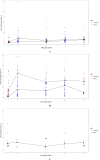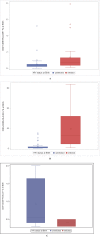Potential Role of Regulatory T Cells in Mother-to-Child Transmission of HIV
- PMID: 30760190
- PMCID: PMC6446459
- DOI: 10.2174/1570162X17666190213094624
Potential Role of Regulatory T Cells in Mother-to-Child Transmission of HIV
Abstract
Background: Mother-to-child transmission of HIV-1 occurs in a minority of HIVinfected mother-infant pairs, even without any interventions. The mechanisms that protect the majority of HIV-exposed infants from infection are unclear. T regulatory cells (Treg) have important immunomodulatory functions, but their role in the fetus as well as in mother-to-child transmission of HIV is under-studied.
Methods: We studied available cryopreserved peripheral blood mononuclear cells from HIVexposed infants from the Breastfeeding, Antiretrovirals and Nutrition (BAN) Study cohort in Malawi: 64 infants were HIV-uninfected and 28 infants were HIV-infected at birth. We quantified the frequency of Treg cells (CD4+CD25+FoxP3+), and activated CD4+ and CD8+ T cells (CD38+ HLADR+) by flow cytometry at birth, 6 weeks and 6, 9 and 12 months of age. Descriptive statistics were performed to describe the distributions of these lymphocyte markers according to the HIV infection status; and Student's t tests and Wilcoxon-Rank Sum tests were performed to compare HIVinfected and uninfected infants.
Results: T cell activation increased rapidly in the first 6 weeks of life, more pronounced on CD8+ T cells; a further increase in activation was observed at the time of weaning from breastfeeding at 6 months of age. In contrast, the frequency of Treg was stable over the first 6 weeks of life (median, 0.5%), slightly decreased between 6 weeks and 6 months (median at 6 months, 0.3%) and then slightly increased between 6 months (time of weaning) and 12 months of age (median, 0.45%). HIVinfected infants had significantly higher frequencies of activated T cells than uninfected infants (P < 0.01). At the time of birth, HIV-exposed uninfected infants had higher levels of Treg, compared to infants infected in utero, even though this did not reach statistical significance in this small sample size (P = 0.08).
Conclusion: This study provides initial evidence that Treg may play a role in preventing mother-tochild transmission of HIV, likely by suppressing immune activation in the fetus and infant, and needs to be substantiated in a larger study. Better characterization of the role of Treg in fetal and neonatal immunity may provide a valuable complementary approach to achieve eradication of mother-to-child transmission of HIV.
Keywords: HIV; Treg; infant; mother-to-child transmission; neonate; regulatory T lymphocytes..
Copyright© Bentham Science Publishers; For any queries, please email at epub@benthamscience.net.
Figures



Similar articles
-
Strong HIV-1-specific T cell responses in HIV-1-exposed uninfected infants and neonates revealed after regulatory T cell removal.PLoS One. 2006 Dec 20;1(1):e102. doi: 10.1371/journal.pone.0000102. PLoS One. 2006. PMID: 17183635 Free PMC article.
-
Significantly skewed memory CD8+ T cell subsets in HIV-1 infected infants during the first year of life.Clin Immunol. 2009 Mar;130(3):280-9. doi: 10.1016/j.clim.2008.09.006. Epub 2008 Nov 8. Clin Immunol. 2009. PMID: 18996749 Free PMC article.
-
The reference range of CD4+ and CD8+ T-lymphocytes in healthy non-infected infants born to HIV-1 seropositive mothers; a preliminary study at Siriraj Hospital.Southeast Asian J Trop Med Public Health. 1998 Sep;29(3):453-63. Southeast Asian J Trop Med Public Health. 1998. PMID: 10437939
-
The Effect of Human Immunodeficiency Virus and Cytomegalovirus Infection on Infant Responses to Vaccines: A Review.Front Immunol. 2018 Mar 2;9:328. doi: 10.3389/fimmu.2018.00328. eCollection 2018. Front Immunol. 2018. PMID: 29552009 Free PMC article. Review.
-
Immune pathogenesis of pediatric HIV-1 infection.Curr HIV/AIDS Rep. 2006 Feb;3(1):13-9. doi: 10.1007/s11904-006-0003-4. Curr HIV/AIDS Rep. 2006. PMID: 16522254 Free PMC article. Review.
Cited by
-
Pregnancy and viral infections: Mechanisms of fetal damage, diagnosis and prevention of neonatal adverse outcomes from cytomegalovirus to SARS-CoV-2 and Zika virus.Biochim Biophys Acta Mol Basis Dis. 2021 Oct 1;1867(10):166198. doi: 10.1016/j.bbadis.2021.166198. Epub 2021 Jun 10. Biochim Biophys Acta Mol Basis Dis. 2021. PMID: 34118406 Free PMC article. Review.
-
Harnessing regulatory T cell neuroprotective activities for treatment of neurodegenerative disorders.Mol Neurodegener. 2020 Jun 5;15(1):32. doi: 10.1186/s13024-020-00375-7. Mol Neurodegener. 2020. PMID: 32503641 Free PMC article. Review.
References
-
- Simonetta F, Bourgeois C.
Publication types
MeSH terms
Grants and funding
LinkOut - more resources
Full Text Sources
Medical
Research Materials

